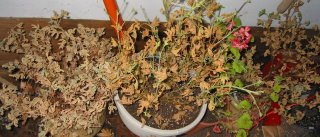
This brugmansia looks like it's doing OK in the garage. It's getting the "dry, dark, and chilly" dormant treatment. This method is recommended on a number of sites. Apparently, Brugmansias originate in low elevations of the tropics - whether they experienced conditions when they were in chilly dark dry situations for a few months, I don't know.

Most of the garden is overwintering in the usual method of leaving things alone for the winter, maybe with some mulch. This is probably OK for everything with a cold-winter provenance. The figs are a bit borderline in this respect, but most should survive here.

Most of the geraniums, like the brugmansia, are getting the chilly / dark / dry treatment. Some gardeners recommend taking geraniums out of the soil. Here too. These are brought into the garage pot and all.
 Some plants won't take the dry /dark / chilly and can't survive outside either. This citrus tree (I'm not sure if lemon, orange, or grapefruit) was grown from seeds 7 years ago, and survives mostly on neglect. It gets light and minimal water inside during Winter. The Anigosanthos is still green, and has produced a couple of small flowers in December. A few more seem to be pushing up from the leaves. It's getting minimal water in the same window. This is my first attempt at this plant - no way to guess if it will survive another 3-4 months of this treatment. So far, OK. I think it is not dormant, just slowed down.
Some plants won't take the dry /dark / chilly and can't survive outside either. This citrus tree (I'm not sure if lemon, orange, or grapefruit) was grown from seeds 7 years ago, and survives mostly on neglect. It gets light and minimal water inside during Winter. The Anigosanthos is still green, and has produced a couple of small flowers in December. A few more seem to be pushing up from the leaves. It's getting minimal water in the same window. This is my first attempt at this plant - no way to guess if it will survive another 3-4 months of this treatment. So far, OK. I think it is not dormant, just slowed down.Two of the geranium cuttings died (forgot to water for several weeks) but this one managed to pull through.
I tried to learn about dormancy. A number of writers seem to view it as being like a human who needs sleep. I suspect that's not proven. I think that it depends on the plant, where it came from (it's provenance), and how it's being treated now. For example, a plant in a purely tropical environment that is the same year round, might not need dormancy. Plants from the desert, which become hot and too dry sometimes, and cold and dry others, might have more than one type of dormancy. Spring bulbs are probably "doing something" when we think they are dormant - growing roots, forming embryo flowers and leaves, so that they can burst forth with rapid growth and blooming as soon as weather allows. Similar for shrubs and trees, with some root growth during the fall or winter, and the formation of tiny flowers and leaves within the buds for a big show in Spring. Some plants actually 'prepare' for dormancy by storing carbohydrates - this is hormonally mediated. Other plants may simply be 'marking time' or surviving adverse weather conditions.
I need a nap.

No comments:
Post a Comment
Note: Only a member of this blog may post a comment.